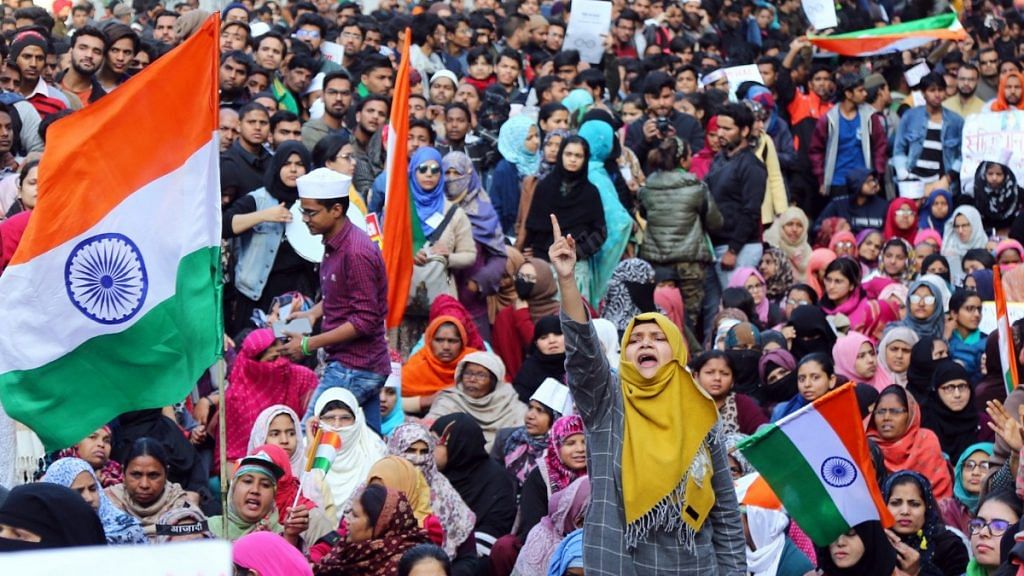The controversial Citizenship Amendment Act has now become a reference point for future political articulations about two ideas of imagining India. And yet, old binaries such as communalism-secularism and nationalism-fascism are still being invoked out of sheer intellectual laziness.
The debate over the Citizenship Amendment Act (CAA) presents a new opportunity to re-imagine tired clichés about the idea of India. There is now a need to look for those ideas that explain the dasha (state of affair) and disha (future direction) of contemporary Indian politics.
The Bharatiya Janata Party (BJP) leadership wants to invoke the idea of citizenship to redefine its aggressive Hindutva-driven nationalism. The anti-CAA protests, in contrast, oppose this law to reclaim what protesters call the true spirit of Indian republicanism.
These conflicting claims produce a new battle of political ideas.
There is an official idea of New India, which is the ideological underpinning of the CAA. On the other hand, there is an equally influential idea of India’s Swadharma (India’s inner-self) that proposes a radical streamlining of our political culture.
Also read: Who represents India’s Muslims? Thanks to CAA protests, we now know the answer
A controllable ‘New India’
New India, we must note, is not simply a political spin. It is a thoroughly worked out ideological framework that the BJP accepted as its political principle in 2018.
Narendra Modi’s official website underlines three features of ‘New India’: A nation driven by innovation, hard work, creativity; a nation characterised by peace, unity, brotherhood; and a country free of corruption, terrorism, black money, and dirt.
To realise these objectives, Modi’s website asks Indian citizens to take an eight-point pledge. Two of these points are very interesting: “I extend my complete support to an Accessible India”; and “I will be a job creator, not a job seeker”.
In the tradeoff between rights and duties, citizens are called upon to offer uncritical support to the Modi government so as to achieve what is called an ‘accessible India’. On the other hand, seeking employment as a fundamental right is strongly discouraged. Indian citizens are clearly told that job creation is not a duty of the government; hence, they should not consider it as a right.
In ‘New India’, the government asserts itself as the supreme agency that works on behalf of the citizens in the political sphere, but it keeps itself away from the economic sphere and does not take any responsibility to provide jobs. For Modi, “New India is the era of responsive people and responsive government.”
This ‘selective accountability’ attitude provides an ideological legitimacy to the BJP to justify the dilution of Article 370 and pursuing an aggressive CAA campaign to correct what it calls “historic blunders”. At the same time, this framework empowers them to refute anti-CAA protests as irresponsive experiments.
Also read: Not Savarkar-Golwalkar, roots of CAA lie in RSS chief Mohan Bhagwat’s brand new Hindutva
India’s Swadharma
One of the most constructive critiques of ‘New India’ has come from Swaraj India’s president Yogendra Yadav. His notion of India’s Swadharma not merely provides a theoretical coherence to the anti-CAA protests but also shows that the Indian experience with democracy has transformed it into everyday culture.
Yadav’s conceptualisation of Swadharma is not about the glorious Indian civilisation, which Jawaharlal Nehru aimed to rediscover in his Discovery of India; nor does Yadav reduce it to the constitutional ideals, which are cherished as the solution for everything. Instead, he defines India’s Swadharma as Bharat ka iman — an element that captures the uniqueness of our democratic experiences in the post-1950 period.
Swadharma tries to redefine the much-celebrated Western political ideals of democracy, diversity, and development in the Indian context. Yadav says India convinced the world that democracy could be practiced in conditions of deep disadvantage and lack of formal education.
This is also true about diversity. Yadav suggests that the Indian idea of diversity has not been about celebrating cultural/religious differences but about ‘acceptance of radically different ways of being’.
The idea of development is also redefined as something not limited to GDP growth rate or per capita income. For Yogendra Yadav, “what is distinctive about our contribution to thinking about development is the idea of the last person first” – something M.K. Gandhi had said.
Also read: In 2020, don’t rely on routine rallies and marches. Modi’s India needs new ways to protest
Just India
Swadharma is established as a political-moral principle to reject Modi’s ‘New India’ formulation. It argues that the CAA and the Article 370 move go against the Indian conceptions of diversity. Similarly, the lethargic and irresponsive attitude of the Modi government in the economic sphere is shown as a political betrayal.
The constructive proposal in it is an appeal to transform the anti-CAA movement into a Bharat Jodo Andolan, linking the citizenship issue with other ongoing people struggles such as farmers’ movements and the demand to have an NRU – National Register of Unemployed. This takes us beyond the action-reaction politics that revolves around Shaheen Bagh.
It is clear that Modi’s New India aims to produce obedient, disciplined and governable citizens. It relies on a power-centric interpretation of the Constitution and a Hindutva-driven nationalism. The idea of India of Swadharma not only rejects New India on moral-political grounds but also proposes a humane, inclusive and participatory vision to achieve what could be called a believable idea of Just India.
No one knows the fate of the anti-CAA movement. But the ideological struggle between New India and Just India will continue to survive.
The author is a Fellow at the Nantes Institute of Advanced Studies, France (2019-2020) and Associate Professor, CSDS, New Delhi. Views are personal.
